The AMD Trinity Review (A10-4600M): A New Hope
by Jarred Walton on May 15, 2012 12:00 AM ESTAMD Trinity Gaming Performance
After the 3DMark results, you might be wondering if Intel has finally caught up to AMD in terms of integrated graphics performance. The answer is…yes and no. Depending on the game, there are times where a fast Ivy Bridge CPU with HD 4000 will actually beat out Trinity; there are also times where Intel’s IGP really struggles to keep pace. The good news is that at least everyone is now onboard the DX11 bandwagon, and compatibility with games has improved yet again for Intel. Here are our “Value” benchmark results for seven recent games; we’ll have more information in a moment.

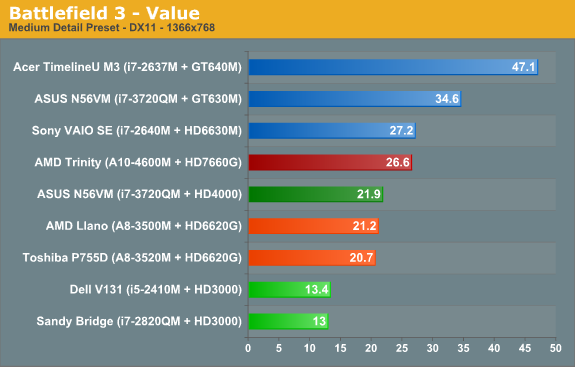
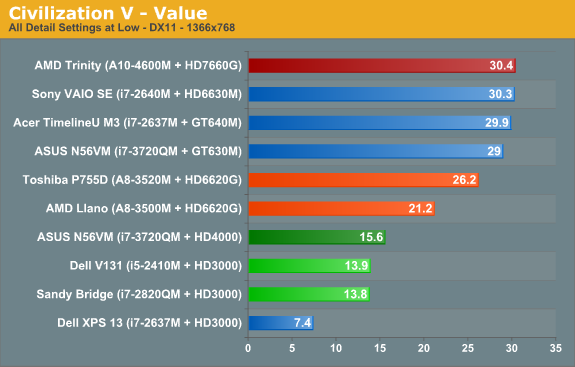

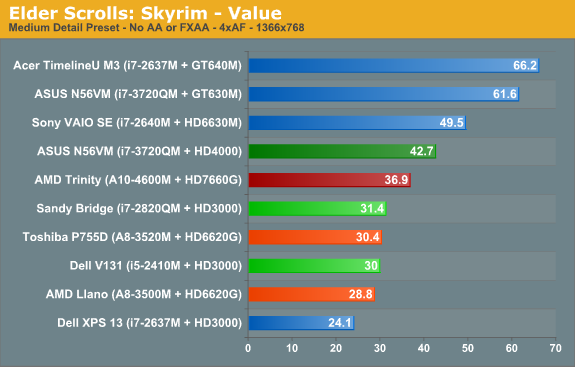
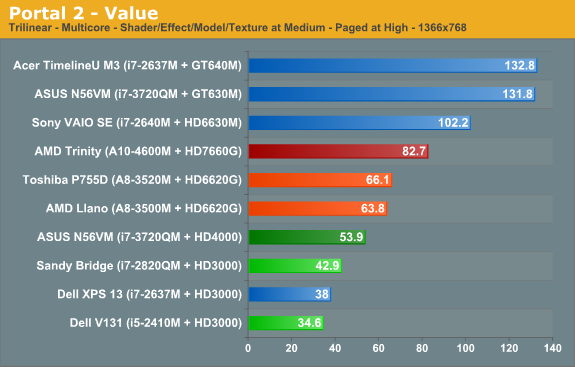
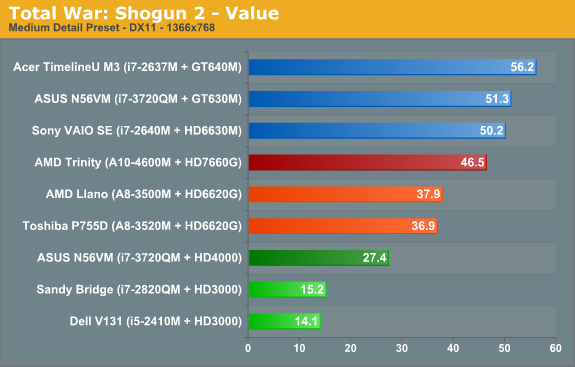
Out of our seven test titles, AMD’s Trinity leads any other IGP in four titles by a large margin. The other three titles actually have Ivy Bridge slightly ahead of Trinity, but the gaps aren’t nearly as big. Overall, the average performance across the seven games at our Value (medium) settings has AMD’s Trinity A10-4600M leading Intel’s i7-3720QM by 21%, and if we look at quad-core Sandy Bridge with HD 3000 (i7-2820QM) Trinity is 72% faster. Trinity is also around 20% faster than 35W Llano on average.
Let’s expand our gaming suite just a bit to see if things change, though. Just like we did with Ivy Bridge, we ran the eight games in our previous benchmark suite at medium detail settings. We can then compare performance across a wider 15 title selection to see how Trinity matches up against HD 4000, HD 3000, and HD 6620G (Llano). We’ll start with the bottom (HD 3000/Sandy Bridge) and move up.
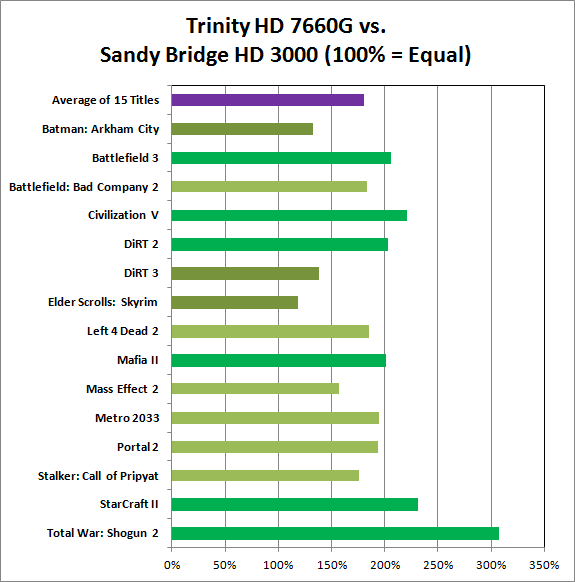
Llano’s HD 6620G was already faster than HD 3000, and Trinity’s HD 7660G is faster than Llano, so the Sandy Bridge gaming matchup is a landslide victory in AMD’s favor. The closest Intel can get is in the same three titles where Ivy Bridge leads Trinity: Batman: Arkham City, DiRT 3, and Skyrim. Here, however, HD 3000 can’t actually close the gap and HD 6620G is at least 20% faster than HD 3000, with an average performance improvement of nearly 80%.
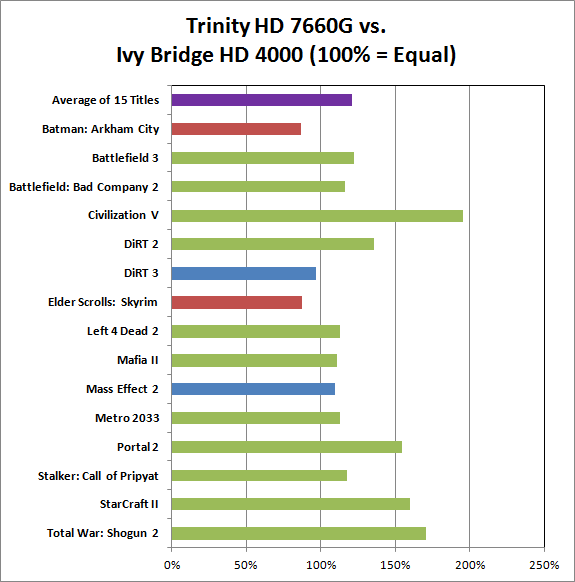
We found that across the same selection of 15 titles, Ivy Bridge and Llano actually ended up “tied”—Intel led in some games, AMD in others, but on average the two IGPs offered similar performance. This chart and the next chart will thus show a similar average increase in performance for Trinity, but the details in specific games are going to be different. Starting with Ivy Bridge and HD 4000, as with our earlier game charts we see there are some titles where Intel leads (Batman and Skyrim), a couple ties (DiRT 3 and Mass Effect 2), and the remainder of the games are faster on Trinity. Mafia II is close to our <10% “tie” range but comes in just above that mark, as do Left 4 Dead 2 and Metro 2033. The biggest gap is Civilization V, where Intel’s various IGPs have never managed good performance; Trinity is nearly twice as fast as Ivy Bridge in that title. Overall, it's a 20% lead for Trinity vs. quad-core Ivy Bridge.
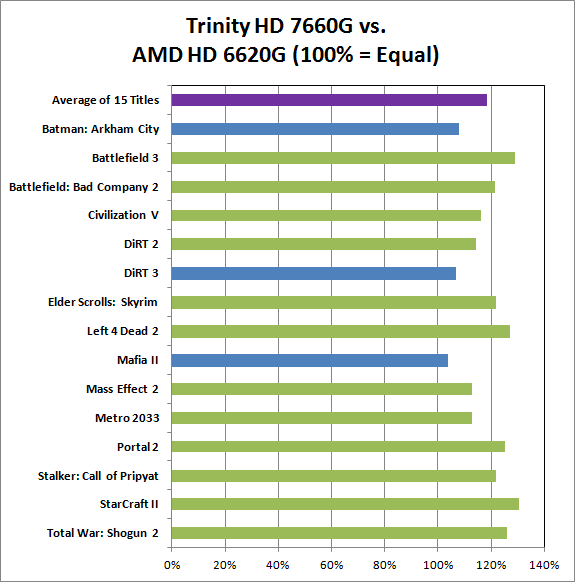
Against Llano, Trinity is universally faster, but the smallest gap is in Mafia II (3%) while the largest gap is in StarCraft II (30%). On average, looking at these games Trinity is only 18% faster than Llano. What’s not entirely clear from the above chart is whether we’re hitting CPU limitations, memory bandwidth limitations (remember that Llano and Trinity share bandwidth with the rest of the system), or perhaps both. At our chosen settings, what is clear is that Trinity’s “up to 56% faster” graphics never make it that high.
We saw 35-45% higher scores in 3DMark 11 and Vantage, which tend to remove the CPU from the equation more than actual games, so our guess would be that if AMD continues with their APU plan they’re going to need to work more on the CPU side of the equation. We also see the same thing looking at the VAIO SE scores in the earlier gaming charts: the HD 6630M scores are 20% faster on average, but much of that appears to come from the faster CPU rather than the GPU.










271 Comments
View All Comments
texasti89 - Tuesday, May 15, 2012 - link
A10-4600M's TDP = 35W
I7-3720QM's TDP = 45W
I'm pretty sure that Intel's 22nm is more power efficient that any 32nm process available in the industry. The efficiency of Intel GPU architecture is what makes their graphic solution appears to be comparable to AMD fusion parts.
Lolimaster - Tuesday, May 15, 2012 - link
As obviously with the biased reviewers.Yeah GJ. Compare a top of the line UBER-expensove IB quad core with the highest TDP and the highest frequency vs A10 Trinity wich costs 3times less(if not more) thant that i7 3720QM.
HD4000 performance is craptastic. Don't fool people with biased comparisons, at medidum detail and low res, cpu take advantage. For mobile each Mhz towards the 3Ghz and above improve performance.
BUT WE ARE TALKING ABOUT AN i7 IB 3x times MORE EXPENSIVE than Trinity with WAY HIGHER MHZ. It's not the pathetic HD4000 that is shining is just the cpu, you can put an HD6450M and it will appear "faster" than Trinity if you pair with a high end expensive cpu.
It's like the moronic reviews with a i7 3770K ($300+) vs A8-3870K ($120).
Everyone knows that the real competion are the dual core i5 and similar price.
And again, medium details when APU's prooved to offer high quality in most games.
JarredWalton - Tuesday, May 15, 2012 - link
http://www.anandtech.com/bench/Product/600?vs=580I've got Mainstream and Enthusiast performance results in there for the games, but there's not much point in running games at 1600x900 High settings at <30 FPS is there?
I have a whole section stating why we're including the systems we're including. Are you seriously delusional enough to suggest that we not show HD 4000 performance? There are no other HD 4000 results available for the time being, so either I use the i7-3720QM or I omit Ivy Bridge entirely. For you to imply its inclusion (with the note--italicized even!--that "these two laptops do not target the same market") is somehow biased is in fact far more bias than anything I've shown. And the pricing is twice as high for the ASUS system, not three times -- in fact I'd guess the Trinity laptop would be closer to $800 as configured, since it has Blu-ray and an SSD.
What's more, throughout the review, I've included dual-core i5-2410M results and discussed how AMD's Trinity stacks up. Judging by Sandy Bridge, dual-core Ivy Bridge will be within 10% of the quad-core scores for gaming--it's not like many games can use more than two CPUs, and so it's really just a matter of the HD 4000 clocks being slightly lower on i5 models. You fail to grasp this fact with your ranting and biased outlook, unfortunately.
In other words, I think your "moronic reviews" comment reflects your reading comprehension skills--or lack there of. Better luck next time. You might want to sign up for the remedial math and basic reading classes at the local community college.
kyuu - Tuesday, May 15, 2012 - link
"I've got Mainstream and Enthusiast performance results in there for the games, but there's not much point in running games at 1600x900 High settings at <30 FPS is there?"Is that that the FPS you get? Did you actually test this or just assuming? Also, you can run 1600x900 without automagically turning up the detail settings to High at the same time. I, for one, am interested to see if the performance advantage increases over Llano/HD4000 when you shift more of the burden to the GPU side. At x768, it seems like the CPU would still be handling enough to make the CPU a substantial bottleneck.
JarredWalton - Tuesday, May 15, 2012 - link
Yes, the scores in Mobile Bench are all actually tested -- including the 5 FPS average score of Trinity at 1920x1080 with 4xAA in Battlefield 3. (Yes, watching that made me feel a bit nauseous....) I could test 1600x900 at medium detail, but I don't expect any major changes from what the existing scores show.Denithor - Tuesday, May 15, 2012 - link
Actually those facts are very interesting to some of us! It lays out what the system can/cannot handle in practical terms. Now, granted, BF3 @ 1080p/4xAA is kinda an obvious fail scenario, but 1080p medium detail might be good to know.One real question that I haven't seen mentioned yet - how come there were no Intel cpu + nVidia gpu systems included in this testing? That seemed like a no-brainer to me...
JarredWalton - Wednesday, May 16, 2012 - link
I thought the Acer TimelineU was a good choice. The only other recently tested laptops with Intel + NVIDIA are the Razer Blade (if people complain that N56VM is too expensive, what would they say about a $3500 laptop!?) and the Alienware M17x R3 (completely different class of hardware and again over $2000). The others like Dell XPS 15z came before we changed our game list, so we don't have some of the results for such laptops.vegemeister - Tuesday, May 15, 2012 - link
CPU speed doesn't become significant at low resolution because the resolution is low, but because the frame rate is high. The CPU must create the scene to be rendered at much higher temporal resolution.bji - Tuesday, May 15, 2012 - link
I think this was a well written article and that you laid out the facts about as clearly as could be laid out. I agree that Lolimaster has poor reading comprehension and needs some remedial education.raghu78 - Tuesday, May 15, 2012 - link
OEM laptop pricing is what changes the discussion. Also the sandybridge stock clearing firesale is a crucial factor. Given that core i7 2630qm with nvidia GT 555M is at USD 800 and entry level core i5 laptops at USD 550http://www.newegg.com/Product/Product.aspx?Item=N8...
http://www.newegg.com/Product/Product.aspx?Item=N8...
The A10 trinity laptops need to come at USD 600 with a max of 650 for the best designs, with the A8 at 500- 550 and the A6 / A4 at USD 400 - 450.Then they can clearly avoid competing core i7 with discrete GPU configs and be considered good alternatives for the low end Intel core i5, core i3 and pentium/ celeron dual cores with crappy intel HD 3000 graphics. Not to forget the the GPU drivers advantage which AMD has, very good image quality and a rapidly growing GPU accelerated apps ecosystem.